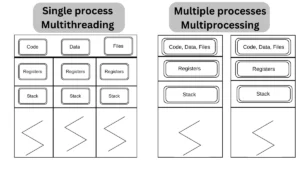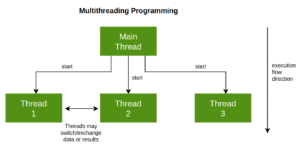Benefits and Issues with Multithreading
Multithreading is a powerful technique used to enhance application performance, responsiveness, and resource utilization. However, while multithreading can offer several advantages, it also introduces complexity and potential issues that developers must manage carefully.
This section outlines both the key benefits and common challenges associated with multithreading in modern computing.
Benefits of Multithreading
- Improved CPU Utilization
Multithreading allows multiple threads to run concurrently within the same process. This helps keep the CPU busy by executing other threads while some are waiting (e.g., for I/O or network operations), leading to better resource usage.
- Faster Execution for Concurrent Tasks
Applications that can divide work into independent tasks (e.g., video encoding, search algorithms) can complete faster by running these tasks in parallel threads, especially on multi-core processors.
- Better Responsiveness
In GUI-based applications or real-time systems, multithreading improves user experience. For example, one thread can handle user input while another processes data, preventing the interface from freezing.
- Simplified Program Structure for Asynchronous Tasks
Multithreading can simplify code that needs to perform asynchronous or background operations, like timers, downloads, or real-time monitoring, by separating them into dedicated threads.
Issues and Challenges with Multithreading
- Race Conditions
When multiple threads access shared data simultaneously, inconsistencies can occur. If one thread modifies a variable while another is reading it, and no proper synchronization is in place, this leads to unpredictable behavior.
- Deadlocks
A deadlock occurs when two or more threads are each waiting for the other to release a resource. This circular wait condition can cause the application to hang indefinitely, and it’s often difficult to detect and resolve.
- Complex Debugging and Testing
Multithreaded applications are harder to test because bugs may not appear consistently. Timing issues, order of execution, and thread interleaving make errors intermittent and difficult to reproduce.
- Increased Memory Usage and Overhead
Each thread requires its own stack and context, which adds to the overall memory consumption. Creating too many threads can lead to resource exhaustion and performance degradation rather than improvement.
- Context Switching Overhead
Frequent switching between threads consumes CPU time due to saving and restoring contexts. Excessive thread switching can reduce performance, especially if the thread workload is not balanced.
Real-life Use Cases
- Web servers use multithreading to handle thousands of concurrent connections.
- Mobile apps use threads to load content in the background without affecting the UI.
- Games and simulations leverage threads for real-time physics, audio, and rendering.
Summary
Multithreading offers clear benefits in terms of efficiency, speed, and user experience, particularly in multi-core environments. However, it also introduces complexity, synchronization challenges, and debugging difficulties. Writing safe and efficient multithreaded code requires careful design, proper use of locks, and awareness of concurrency issues.

